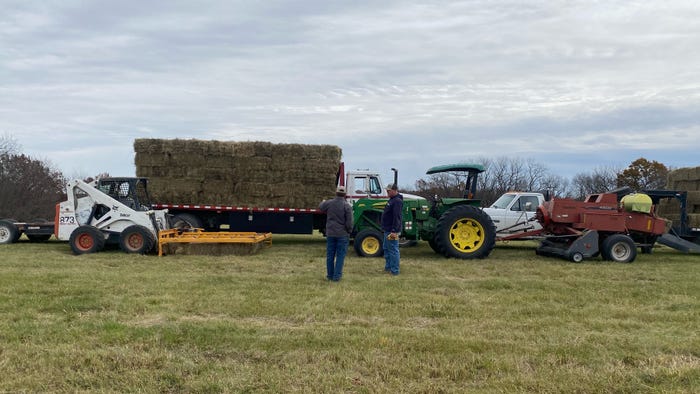
Colton Kiso always wanted to be a farmer, but he struggled to find land and money to get started.
“I love farming but didn’t want to go into debt,” the Pettis County, Mo., farmer says. “I want to be able to have a farm that generates money and does not just feed the banks. Hay is the cheapest crop to get into.”
The 23-year-old bucked the farming trend of investing in high-dollar land and expensive equipment and created his own path to becoming a hay farmer, where he grows forage on small acres and sells it using word of mouth and social media markets. And Kiso sells every bale, every year.
Why turn to Facebook Marketplace?
Kiso started the hay business to feed the family goat herd. At 18, he purchased his first baler. It was a small, older square baler — but that fall he, along with his father, Jeremy Kiso, put up 600 bales.
“It was way more than we needed,” he admits. “I put a small ad on Facebook Marketplace for any we didn’t use, and they all sold.”
The early success made him rethink his farm strategy. “The profit margin was better with hay than the goats,” he says. “So, we started ramping up our production and output.”
Kiso says they purchased quality equipment over time to allow the father-son duo to bale more hay but also rent more acres.
“The nice thing about the ground we pick up is that many of the big ag guys that run row crops can’t fit into smaller fields,” he explains. “So we’re finding little fields that we can harvest for square bales.”
The bale size of choice is 14 by 18 by 36 inches. “There is a need for this size of hay bale, and Facebook Marketplace is a good way to reach those looking for it,” he notes. “There are still more buyers than we have forage available in any given year.”
How to price hay
As a young farmer, Kiso asked for advice on pricing hay but admits there was not a set formula. What he found was hay prices are set typically by the neighbor’s price. That marketing plan doesn’t work for Kiso.
“One farmer may use more or less fertilizer,” he notes. “You cannot charge what someone else is charging, because they don’t have the same product. Each person bales hay differently. Each person’s quality standards are different. You have to determine price for yourself.”
Kiso factors in all of his costs — rent, equipment, fertilizer and labor. Then, he establishes a price based on cost and hay quality.
“Not everybody wants the top-shelf hay,” he says. “I have those who want just roughage to feed a mule.”
Kiso says at least 75% of his buyers are repeat customers, with some traveling hours to buy his hay. It’s a matter of matching the hay to the buyer.
“There is a market for every type of hay; you just have to find the right person to buy it.” For that, he says Facebook Marketplace works for him.
Seller beware
Drought across the Western U.S. drew down 2022 hay stocks to just 71.9 million tons — the lowest Dec. 1 number reported by USDA since 1954. This caused a boom in new seedings of alfalfa and alfalfa mixes to the tune of 1.68 million acres. And a number of those new seedings are farmers looking to diversify from row crop commodities into hay, either as a side business or as a new farming enterprise.

SELLER BEWARE: Farmers just starting out with selling hay should practice caution to avoid falling for scams. Something as simple as loading at a neutral location can help add to your safety.
Some sell direct like Colton Kiso, either online or by word of mouth. But depending on their resources, farmers might also consider contracting their hay to a dairy like Royal Farms Dairy, Cimarron, Kan., or even selling their hay to a broker like Loewen Farms Feed Store, Garden City, Kan.
Whichever market outlet, caution is the word of the day when you’re selling hay.
Use your cow sense. Kiso’s rule of thumb is to not sell hay via text or an online message. He asks buyers to call him so he can determine if they’re legitimate. Tony Loepky with Loewen Farms Feed Store advises farmers to ask their neighbors about buyers before committing. The hay business is built on reputation, and checking with your trusted neighbors may help you avoid a scammer.
Know your buyer. Kyle Averhoff, managing partner of Royal Farms Dairy, says if you’re going to try to sell to a dairy or feedlot, know their needs. “It’s a non-starter for us if the hay is put up in anything other than a square bale,” he says. However, a round bale may find a different market, such as through a hay broker. You may be able to add value to your bales by offering storage and transportation, too. Or, in the case of a broker, you may find some value in having them take the storage and transportation off your bottom line.
Know your product. If you’re going to sell hay, invest the time to bale and store it in a manner that will keep its quality, Averhoff and Loepky say. Operate your equipment to keep leaves on the stem and in the bale, Loepky says. Put it up at the right moisture, and store it off the ground or in a well-drained area. Pull samples so you can accurately market the bale on its feed value. “Definitely keep all your different cuttings separate,” Loepky adds.
Stand by your word. Long-term success in the hay business depends on building solid relationships. Averhoff says even if you are just looking to sell excess hay one season, it might turn into a longer-term contract if you deliver what you promised. Loepky says brokers will often take on farmers based on recommendations from other farmers that they are true to their word. For Kiso, if a customer proves to be a problem, he won’t sell to them again.
Be safe. Kiso’s rule is to meet buyers at neutral locations, away from his house, for physical safety. But you also want to be wary of letting a load of hay leave your farm without payment of some sort, say Loepky and Averhoff. Whether that’s cash, a check from a local bank, a money order or an online payment clearinghouse like PayPal, look at your options, Kiso advises.
About the Author(s)
You May Also Like








